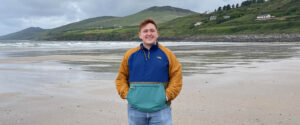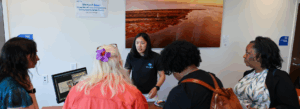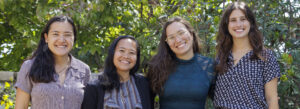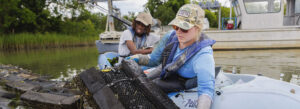Virginia’s historic clam industry
gains
new genetic insights
Virginia’s hard clams were worth nearly $39 million dollars when they went to market in 2018. Virginia leads the nation in hard clam production — it’s the “bread and butter” of Virginia’s shellfish aquaculture.
Even so, there’s still a lot left to learn about the underlying factors that determine clam growth, hardiness, and survival — a clam’s genes — and almost no genetic resources available to the industry, according to Virginia Sea Grant Graduate Research Fellow Ann Ropp. Ropp aimed to change this and provide insights for the industry through her research on hard clam population genetics as a master’s student at the Virginia Institute of Marine Science.
“Genetics can be useful for aquaculture breeding, but to get to the stage where you are able to do that, you first need a solid base of genetic information, which is where my study looking at wild clams comes in,” Ropp said.
Unlike the oyster aquaculture industry, where genetic research has enabled selective breeding to grow hardier oysters, the clam aquaculture industry hasn’t developed comparable genetic tools. That’s in part because the broodstock — the clams selected for breeding — is proprietary information specific to each clam hatchery.
Ropp’s research focused on SNPs, or “snips” in genes — single nucleotide polymorphisms that are small genetic differences between individual clams. Each of these small differences, taken together, act like a “fingerprint” to distinguish clams from one another. She found 154,000 SNPs, and narrowed these down to about 5,000 molecular markers that distinguished different populations of clams from one another.
Ropp analyzed the DNA of about 450 hard clams from all along the East Coast, ranging from Prince Edward Island, Canada, down to South Carolina. Her research is the largest-scale genetic study for hard clams, sampling clams from the most locations and analyzing the most genetic markers.
“We were able to delineate several clam populations, and that’s helped a lot in terms of establishing experimental broodstock at our Eastern Shore Lab,” said Jan McDowell, a research associate professor at VIMS who co-advised Ropp with VIMS professor Kim Reece.
Ropp found six distinct populations of clams ranging along the East Coast. But specifically, she zoomed in on population differences within the mid-Atlantic and the Chesapeake Bay — the area of interest for Virginia’s clam aquaculture industry. Even though all aquacultured hard clams are the same species, Mercenaria mercenaria, there are regional populations that are genetically distinct from one another.
“We even found differences between Chesapeake Bay clams sampled oceanside near Wachapreague on the Eastern Shore and samples we took in the James River,” McDowell said.
Ropp analyzed the DNA of about 450 hard clams from all along the East Coast, ranging from Prince Edward Island, Canada, down to South Carolina.
Ropp’s research focused on SNPs, or “snips” in genes — small genetic differences between individual clams.
Comparing these small differences among clams grown in different regions allowed Ropp to distinguish populations of clams that were distinct from one another. Her research can also be combined with new studies that show how individual clam genes are linked to traits like salt tolerance, growth rates, and shell strength.
“We can use the markers I’ve identified to say, ‘These are the markers that differentiate Wachapreague clams from clams in the James River, and we can see that some of those markers are related to genes that do different things. Then they can select for those genes. Having that resource is a big step forward.”
Down the road, Ropp’s research could be used to develop a “SNP chip,” a device that can determine a clam’s genetic profile. The chip, which looks like a tiny Connect Four board, has small compartments that each test for a specific genetic marker. Once researchers know which markers correspond to which genes, they can use the SNP chip to look for the gene variants that give clams tolerance to low salinity.
This would give aquaculture breeders a quick and inexpensive way to find clams that grow faster or withstand lower salinity. Record rainfall in 2018 and 2019 stressed clams, resulting in slower growth and lower yield for growers, according to Karen Hudson, a shellfish aquaculture specialist at VIMS. If clams can tolerate lower salinity, clam aquaculture could potentially expand beyond the saltiest water of the Chesapeake Bay and along the Eastern Shore.
“Clams really can’t withstand those pulses of lower salinity, so it hurt the clam industry,” Hudson said. “If we’re going to see wetter conditions, it certainly would be nice to have a clam that can survive in lower salinity.”
Before breeders can select for specific traits like low salt tolerance, they first have to know what traits — and genes — to look for in their broodstock lines. VIMS researchers are beginning to establish broodstock for hard clams, but before they select the best clams to breed, they want to start with clams that have a wide variety of different characteristics. Ropp’s research showed them the genetic variety available to choose from.
Takeaways:
- Virginia’s hard clams were worth nearly $39 million in 2018, yet few genetic resources exist for the hard clam aquaculture industry.
- VASG fellow Ann Ropp aimed to change this through her research on hard clam genetics.
- Ropp analyzed the DNA of about 450 hard clams from all along the East Coast, and identified six distinct populations of hard clams.
- Her research lays the foundation to improve clam breeding for aquaculture by identifying genes that relate to clam health and salt tolerance.
Photos by Aileen Devlin and Mallory Huxford | Virginia Sea Grant
Video by Aileen Devlin | Virginia Sea GrantPublished May 21, 2021.
If clams can withstand lower salinity, clam aquaculture could potentially expand beyond the saltiest water of the Chesapeake Bay and along the Eastern Shore.





